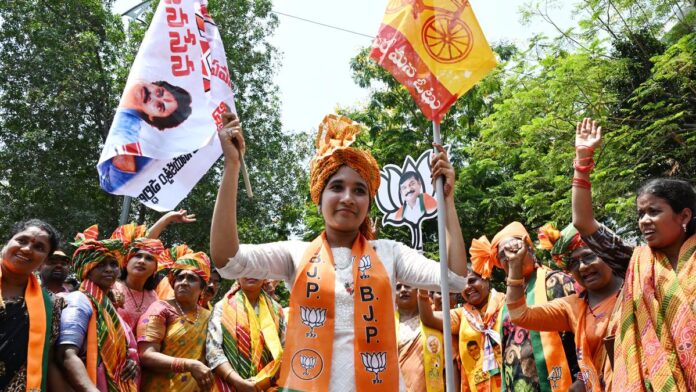As the world’s largest elections are underway, all eyes are on digital platforms and the function they’re enjoying in influencing the citizens. Nonetheless, it might even be time to query the effectiveness of the Mannequin Code of Conduct (MCC) set down by the Election Fee (EC) in making certain free and truthful elections in India.
Part 126 of the Illustration of Folks Act, 1951 prohibits the show of election matter to the general public by tv or related equipment in the course of the 48-hour silence interval ending with the hour fastened for the conclusion of polls. The EC in its varied notifications has clarified that ‘related equipment’ underneath Part 126 consists of social media as nicely. Regardless of clear guidelines prohibiting political campaigning in the course of the silence interval, a examine performed by the CSDS-Lokniti has discovered political events to be spending substantial cash on promoting campaigns on social media throughout this time.
Social media campaigns
It was discovered that BJP posted 60,500 advertisements from April 17 to 19, 2024 on Google and 6,808 on Meta platforms, whereas the Congress posted 1,882 and 114 advertisements respectively throughout the identical interval (Desk 1). This revelation is note-worthy because the Web penetration in India is over 50%.
Out of the full advertisements posted from April 17 to 19 on Google, 500 advertisements, 250 advertisements posted by the BJP and one other 250 posted by the Congress, had been chosen for evaluation utilizing randomised choice. Out of this pattern, 64 advertisements posted by the BJP and 32 posted by the Congress had been discovered to be focused to States/constituencies that voted within the first part of elections (Desk 2).
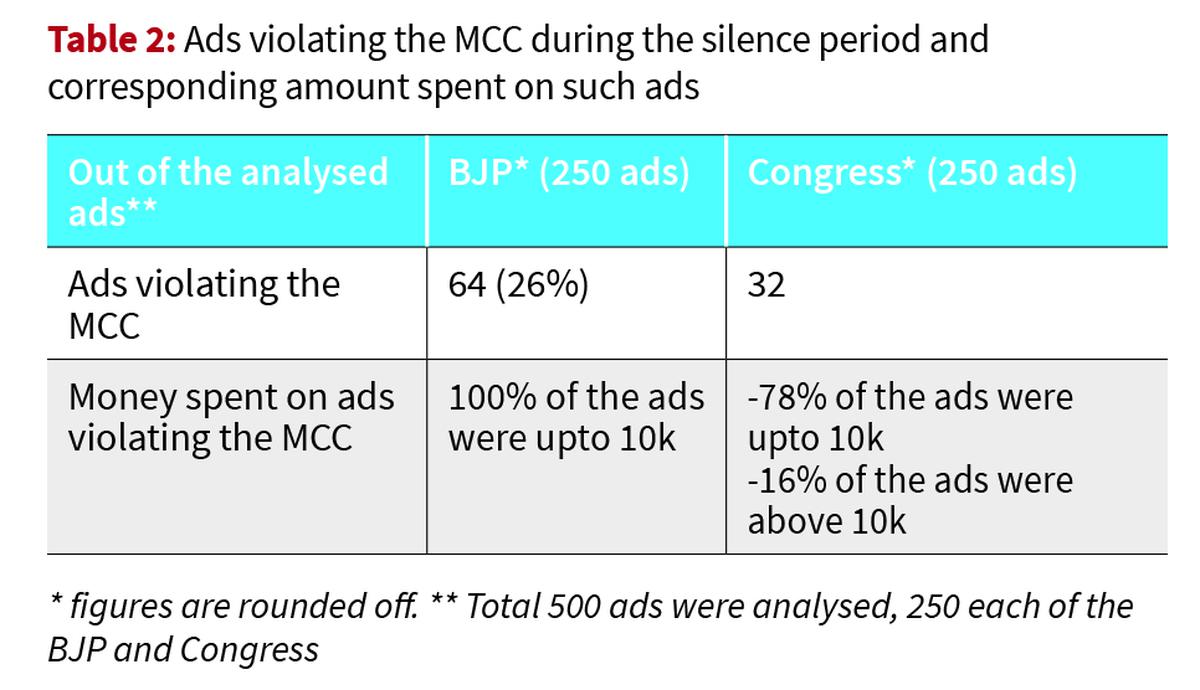
This examine revealed that 13 out of each 50 advertisements of the BJP had been aired in the course of the silence interval in constituencies collaborating within the first part of elections. Notably, political advertisements had been noticed in 11 States and Union Territories previous the primary part of elections, with a number of States being majorly focused (Desk 3).
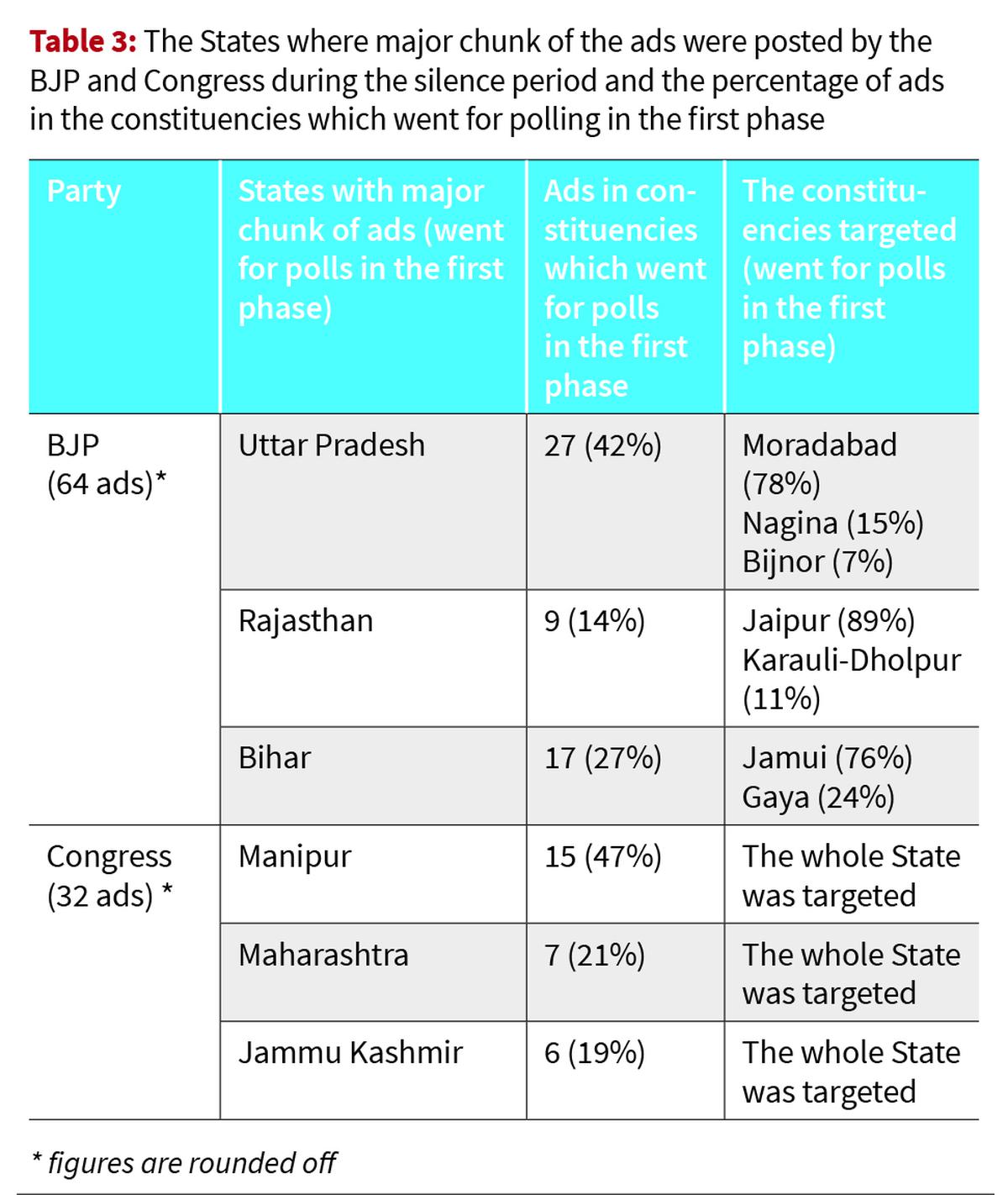
This information underscores the strategic placement and concentrating on of political commercials throughout essential phases of the electoral course of. Of the full variety of Congress advertisements, States voting within the first part of elections had been focused as an entire. Nonetheless, apart from Haldwani within the Nainital constituency in Uttarakhand, no different Congress advertisements particularly micro-targeted any poll-bound constituencies in the course of the silence interval (Desk 3).
The technique of geotargeting
Throughout the silence interval, the BJP’s digital marketing campaign showcased a powerful degree of location based mostly concentrating on precision, evident in its deal with particular locales resembling a panchayat in Baghpat, Uttar Pradesh, and Belthangadi in Karnataka. These situations present only a glimpse into the social gathering’s widespread use of tailor-made methods. Moreover, the BJP focused the Nagina constituency in Uttar Pradesh with a considerable variety of commercials throughout this important interval, recognising the historic significance of the Muslim-Scheduled Caste (SC) mixture in securing victories on this constituency (Desk 4). Nonetheless, the northeastern area remained largely ignored all through the silence interval.
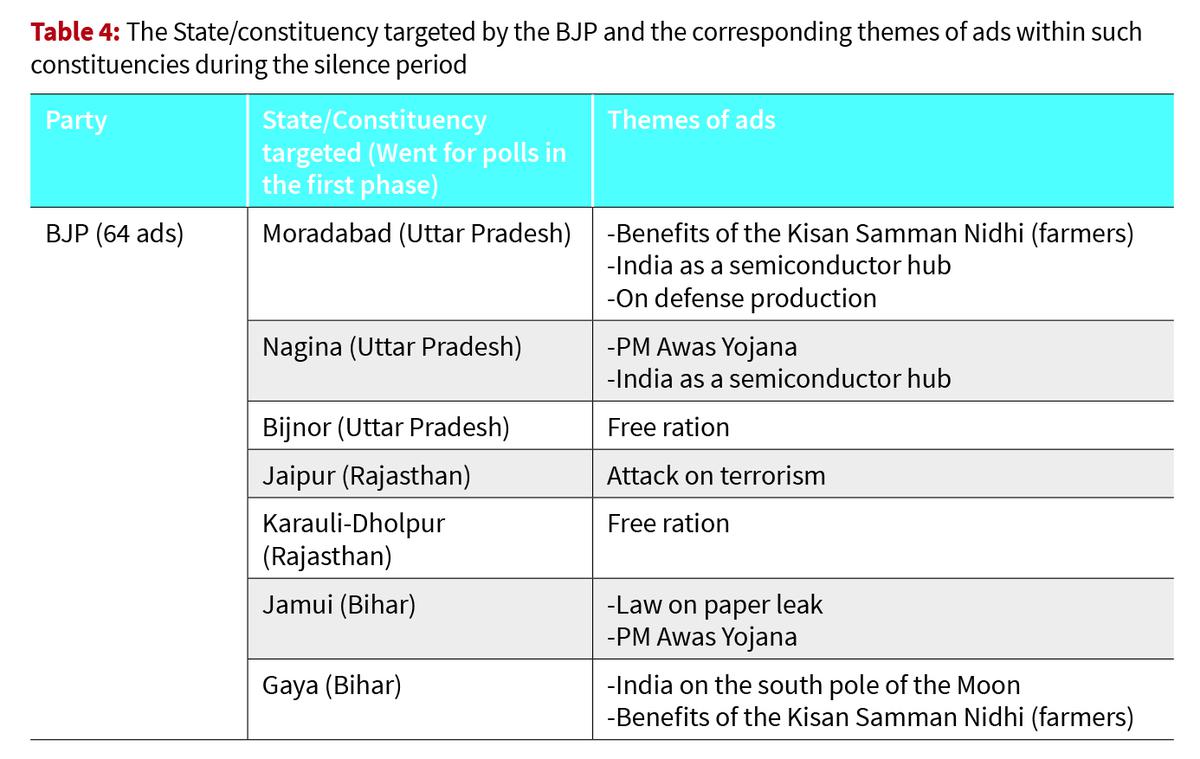
The Congress prevented constituency-level concentrating on. In reality, 42% of Congress advertisements particularly excluded the ballot certain constituencies from the focused States which went for polls within the first part. All of the constituencies in Rajasthan, Assam, Bihar and Chhattisgarh which voted on April 19 had been excluded within the advertisements posted by the Congress in these States. Equally, in advertisements focused to Madhya Pradesh, all poll-bound constituencies, besides Sidhi, had been excluded. Not like the BJP, the Congress was discovered to be vigilant in its presence throughout Manipur with a serious chunk of its focused advertisements specializing in all the foremost themes in the course of the interval of study (Desk 3 and 5).
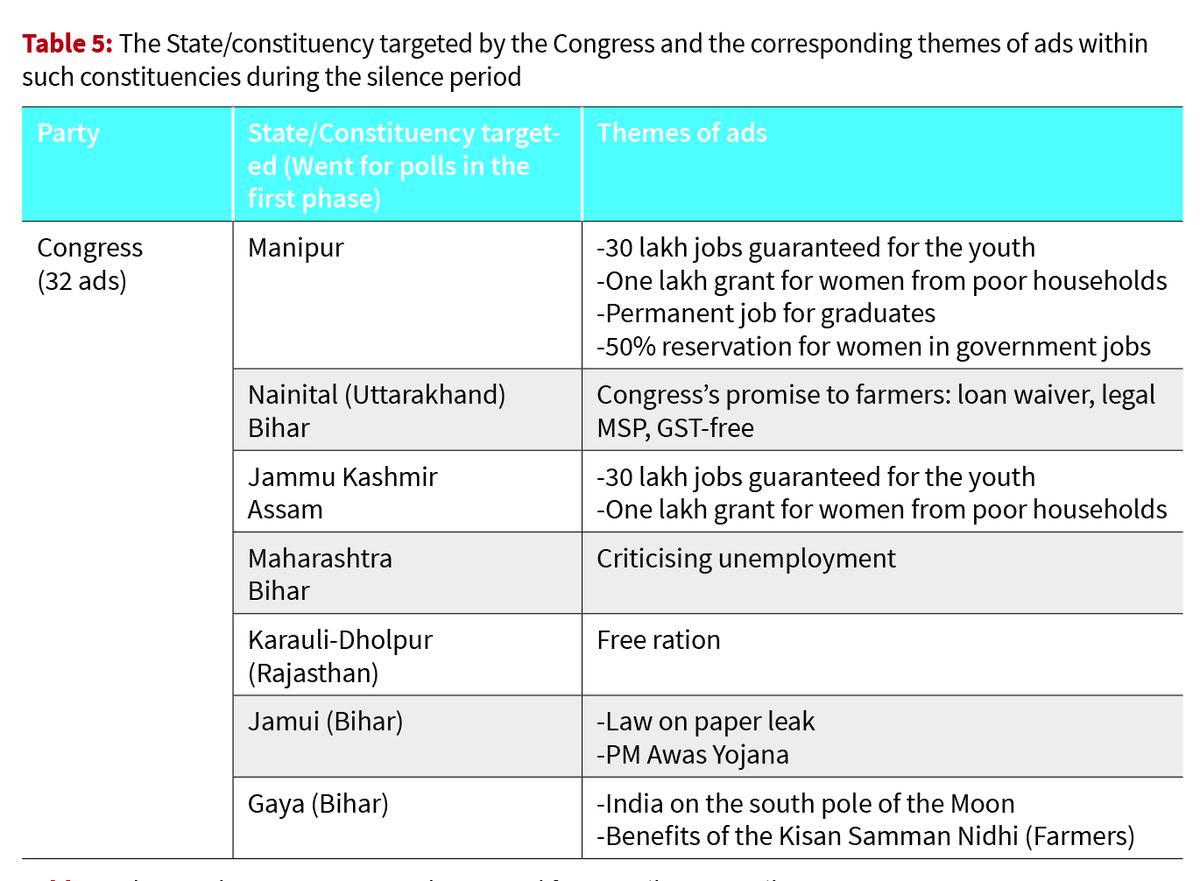
The Meta marketing campaign
Within the case of Meta, the mum or dad organisation of each Instagram and Fb, each the BJP and Congress are seen to have run advert campaigns in the course of the first part of the election. This evaluation is predicated on their official social media handles.
Not like Google advertisements, not one of the advertisements on Meta platforms had been pin code-specific. Nonetheless, they had been State-specific, stating that advert campaigns working in a selected State apply to the territorial space of the entire State, together with these constituencies concerned within the first part of elections. Of the 6,808 advertisements posted by the BJP, a number of advertisements had been circulated in multiple State. For Congress, which posted 114 advertisements throughout this time, Tamil Nadu, Chhattisgarh, and U.P. had been the primary targets (Desk 6).

This information throws gentle on the advert campaigns by the 2 main events on Meta from April 17 to 19, the official silence interval for the primary part of the election.
There’s a clear lead by the BJP within the sheer variety of advertisements posted. There may be additionally a extra diversified marketing campaign from the BJP, in distinction to the Congress, as will be evident from the language during which the advertisements are posted. The BJP has posted advertisements in additional than seven languages, whereas the Congress has posted solely in three.
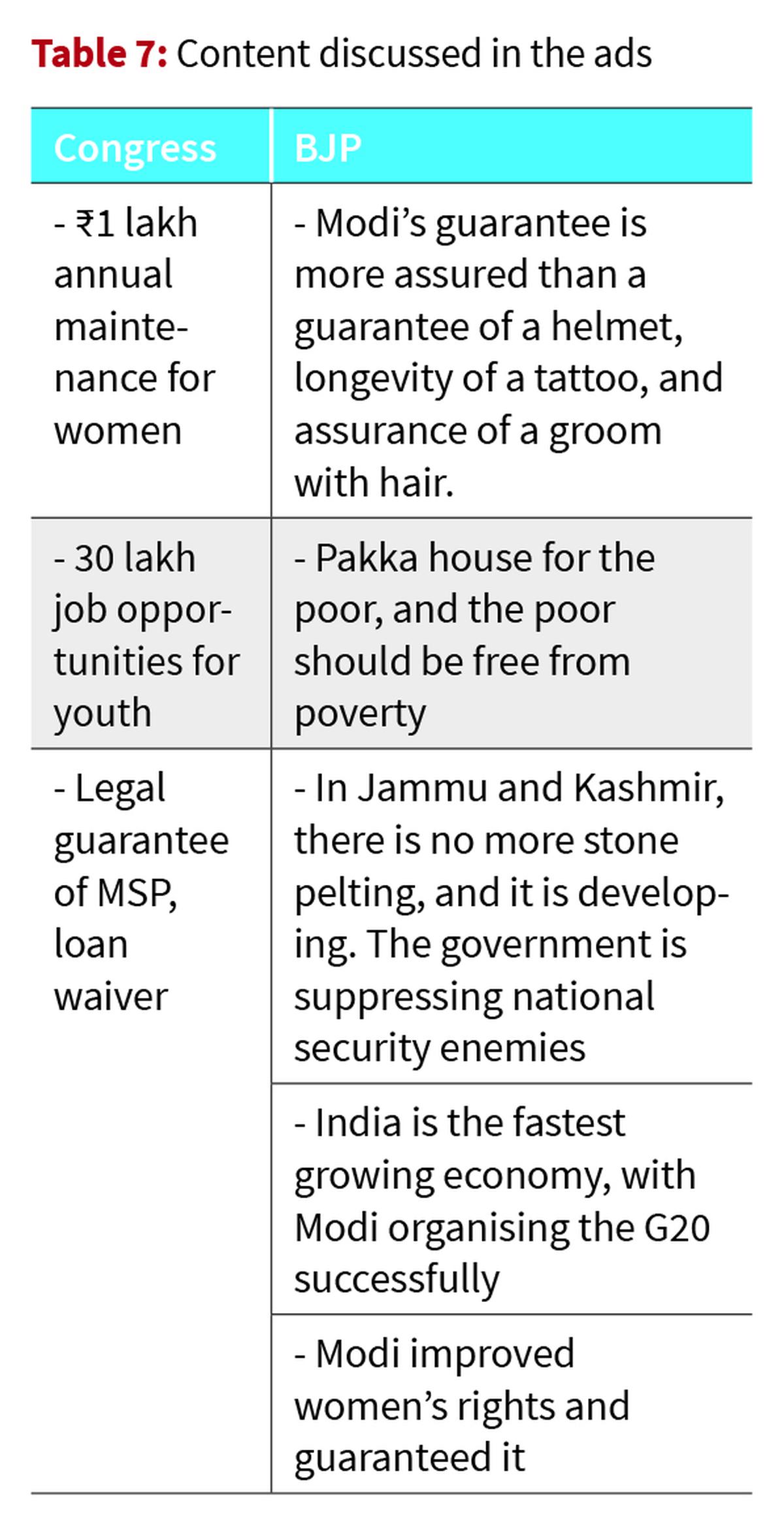
Within the lead-up to the primary part of elections, it turned obvious that political events are stretching the boundaries of the MCC, significantly by digital media advert campaigns. There appears to be a scarcity of preventive in addition to punitive actions taken to deal with such violations, elevating questions concerning the effectiveness of the MCC in making certain free and truthful elections.
By utilising location-based concentrating on in digital campaigns and specializing in key locales, evidently events could have discovered methods to achieve voters throughout a interval when campaigning is restricted.
Because the second part of Lok Sabha elections approaches, it might be price contemplating these observations concerning adherence to the MCC.
Sanjay Kumar is a Professor at CSDS, Aditi Singh is an Assistant Professor at O.P. Jindal International College, and Abhishek Sharma, Hana Vahab, Subhayan Acharya Majumdar are researchers with Lokniti-CSDS.
